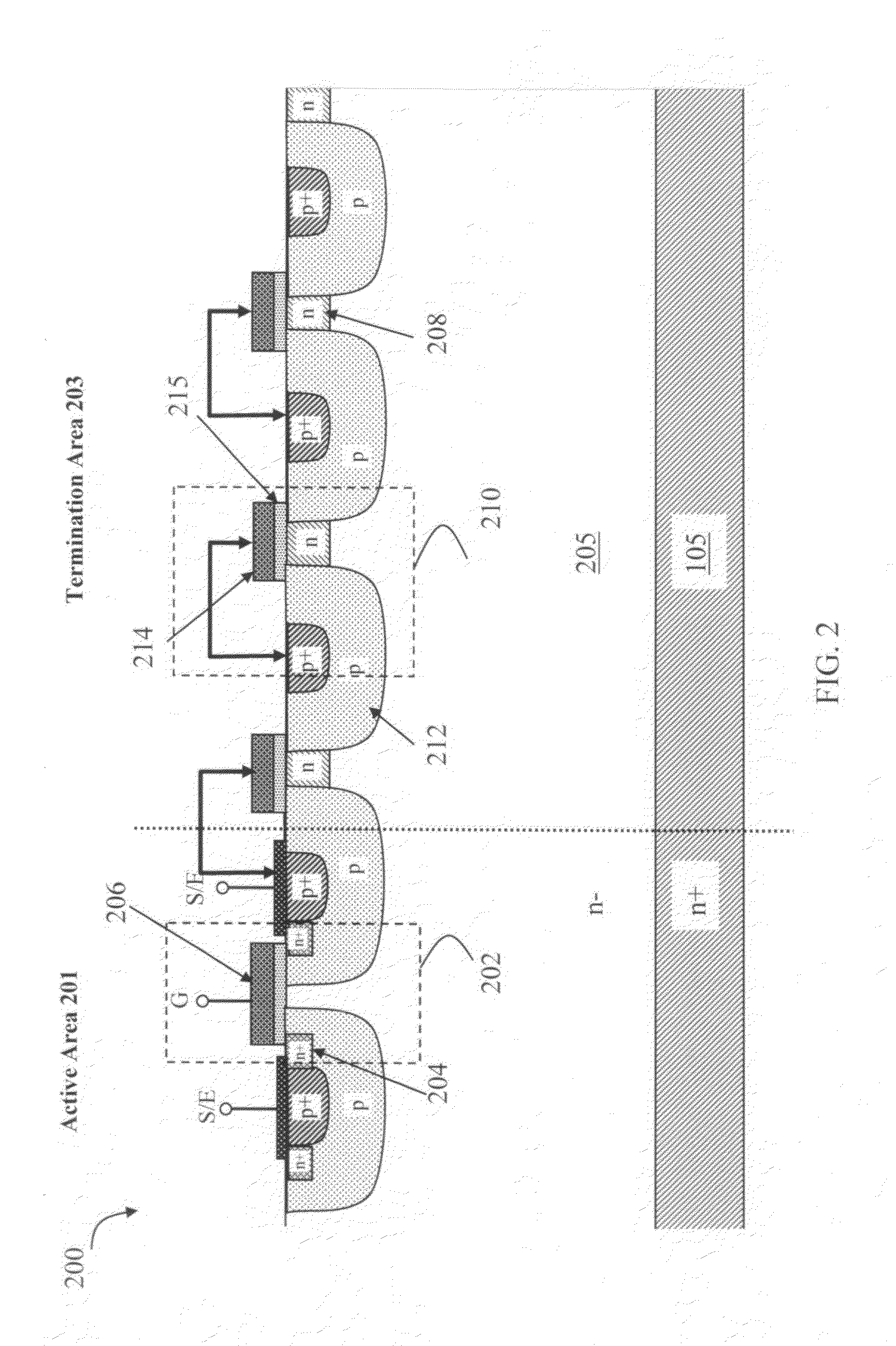Semiconductor device with field threshold MOSFET for high voltage termination
- Summary
- Abstract
- Description
- Claims
- Application Information
AI Technical Summary
Benefits of technology
Problems solved by technology
Method used
Image
Examples
first embodiment
[0023]FIG. 2 is a cross-sectional view of a planar gate HV device 200 of the type depicted in FIG. 1 along line A-A according to the present invention. The HV device 200 is formed on a semiconductor substrate including a lightly doped N-type layer 205 supported on top of a heavily doped layer 105. The doping polarities of heavily doped layer 105 and the lightly doped layer 205 are the same for a HV MOSFET device and are opposite for a HV IGBT device. For simplicity the description in this application only illustrates a HV MOSFET device. The HV device 200 includes an active area 201 and a termination area 203. The active area 201 includes a plurality of planar gate N-channel vertical MOSFETs 202, each of which includes an n+ source 204, a drain formed in the n+ substrate 105 and a planar gate 206. The termination area 203 includes a plurality of P-channel MOSFETs 210, each of which locates between two P-type diffusion regions or two floating guard rings (FGRs) 212. The P-type floatin...
second embodiment
[0026]FIG. 4 is a cross-sectional view illustrating a trench gate high voltage (HV) device 400 according to the present invention. The active area 401 of the device 400 includes a plurality of trench gate vertical N-channel MOSFETs 402, each of which includes an n+ source 404, a trench gate 406 and a drain formed in the n+ substrate 105. Similar to device 200 of FIG. 2, the termination area 403 of the device 400 includes a plurality of P-channel planar gate lateral MOSFETs 210, each of which locates between two P-type diffusion regions or between two FGRs 212, with the gate 214 connecting to the drain electrode 212. The P-channel MOSFET transistors 210 act as a chain between the active area and the scribe region (die edge) in a cascade fashion as described above. The FGR 212 may be formed at the same time the P body region of the active transistor is formed with the same dopant density. Alternatively, the termination area 403 can includes a plurality of P-channel MOSFETs 211 as show...
third embodiment
[0027]FIG. 5 is a cross-section view illustrating another trench gate HV device 500 according to the present invention. In this embodiment, the active area 501 includes a plurality of trench gate vertical N-channel MOSFETs 402 of the type depicted in FIG. 4. The termination area 503 includes a plurality of trench gate P-channel lateral MOSFETs 504, each of which has the same structure as the trench gate MOSFET 402 and locates between two P-type diffusion regions or two FGRs 512. The plurality of termination trenches are formed to have a distance ranging from 0.5 to 5 microns between two adjacent termination trenches and a depth into the semiconductor substrate ranging from 0.5 to 8 microns. The gate material 506 of each P-channel MOSFET 504 functions as a trench gate and is connected to a drain electrode 512 (Drain of the Trench MOSFET is the p-region with more negative Potential). Each FGR 512 between two trench gate 506 in termination area 503 functions as the drain of one P-chann...
PUM
 Login to View More
Login to View More Abstract
Description
Claims
Application Information
 Login to View More
Login to View More - R&D
- Intellectual Property
- Life Sciences
- Materials
- Tech Scout
- Unparalleled Data Quality
- Higher Quality Content
- 60% Fewer Hallucinations
Browse by: Latest US Patents, China's latest patents, Technical Efficacy Thesaurus, Application Domain, Technology Topic, Popular Technical Reports.
© 2025 PatSnap. All rights reserved.Legal|Privacy policy|Modern Slavery Act Transparency Statement|Sitemap|About US| Contact US: help@patsnap.com



